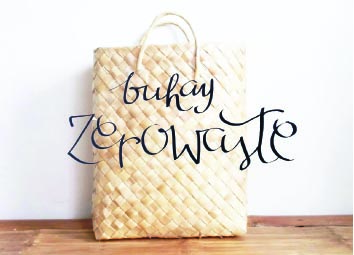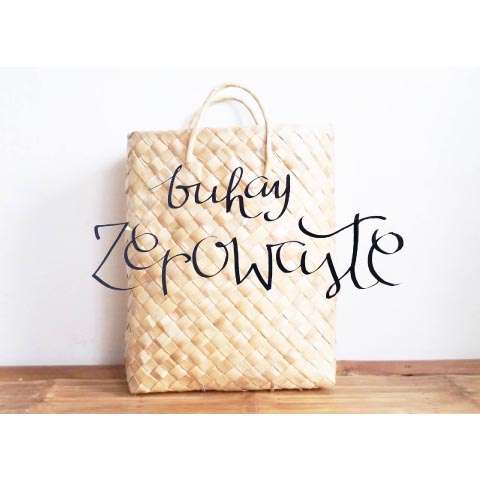 I recently joined a FaceBook group called Buhay Zero-Waste, where members share how they try not to waste, or if unavoidable, waste as little as possible. Members there are on different stages of their journey, so the support for those starting out on the movement is quite awe-inspiring.
I recently joined a FaceBook group called Buhay Zero-Waste, where members share how they try not to waste, or if unavoidable, waste as little as possible. Members there are on different stages of their journey, so the support for those starting out on the movement is quite awe-inspiring.
As I read through the posts, I realize that my small family and I have been trying to live waste-free for quite a while now. More than that, I realize that my husband and I have unconsciously laid the groundwork with our children for living waste free.
Like all my parenting moments that I’m learning along the way, one crucial lesson I learned early on is that everything has to start from early childhood. Our children really take on our habits and lifestyles, and even the way we speak!
In one Buhay Zero-Waste post, someone asked about alternatives to the black trash bags that head to the landfill. There were many suggestions, but the ones that stood out the most are those that said that there are no alternatives, but each trash bag’s capacity could be maximized when we segregate our trash properly.
In that post, I shared with the group that the zero-waste lifestyle, I think, begins with a slight shift in the way we view the things we purchase. When my children and I go grocery shopping, we always buy snacks for school. On our last grocery run, I caught the girls discussing which cookies to buy. Achi was teaching Shobe. “This one na lang. It’s bigger and there’s less basura.”
That’s what I shared with Buhay Zero-Waste group – that when my family and I purchase things that we need, we see our purchases at the outset relating to how much trash we’re purchasing. I don’t even see it as how much trash I would eventually throw away, but that I’m spending good money on trash!
This little tweak on our points of view goes a long way in reducing waste. Whenever we can and are able to, we should buy in bulk so that there is only one packaging material. Best if we could buy package free! And so began our healthier lifestyle.
I drink a lot of coffee and was seeing little packets of sugar and creamer everywhere I turned. Because I did not want to generate more trash from those little packets, I began drinking my coffee black. The bonus – less sugar and processed non-dairy creamer in my diet.
When I began worrying about how much trash the children’s snacks were generating, I told the girls to lessen our snacks purchases to only those they “can’t live without.” We exaggerate, but they love the drama when they tell me they “absolutely need” one thing. We then switched to our trusty pandesal for school snacks. Less sugar, less processed junk, less salt – better fillings when the kids ask for peanut butter or eggs for palaman.
Our pandesal comes package free! The helper brings along a square biscuit tub when buying pandesal – no paper, no plastic.
Which brings me to the paper vs. plastic debate. Plastics destroy the environment. Baggies end up in the ocean, into live animals that eventually die. I had previously written about my doubts about those oxo-degradable plastics. My gut tells me that when the bags break down, they turn into plastic dust, which end up in the ocean and is sucked in by our favorite tuna. I have a feeling that a decade from now, I will be consuming plasticized tuna sashimi. Shudder.
On the other hand, if you search online about paper vs. plastic, various writers state that producing paper bags and plastic bags consume the same amount of energy. As well, producing paper bags consume thrice as much water as producing plastic bags, and produces 70 percent more pollution. I agree with both points of view, ergo, cloth bags.
On this note, when using your cloth bags for grocery shopping, be conscious about the baggers in the checkout lane. They will often put your wet purchases into paper bags before putting them in the ecobags, which totally defeats the purpose of using cloth or having your groceries boxed up.
How about those veggies that already come pre-packed? In most supermarkets, there are loose veggies under the main display area. Or ask the staff for loose veggies. Put these into your own thin bags before having them tagged with prices. [All my grocery boxes go to Kaisa so we could box up donations that we give away.]
In Buhay Zero-Waste group, I found it such an eye opener that metal straws are now becoming an IN thing. My small family has been using four such straws for around three years now. My children kept getting allergic rhinitis, which clogged their ears. Their pediatrician recommended that they drink everything from straws to help unclog their ears, and prevent eventual ear damage.
In the beginning, I bought from the supermarket. After one bag of 50 straws, I started looking for alternatives and found metal straws online. Now, we need to develop the habit of bringing the straws along – we always forget them.
What we never forget is water. My husband gets the raw end of this deal because every time we go out to watch a movie or even to just walk around, he has to carry around four liters of water. The bonus of bringing our own water is that we don’t buy any drinks. We’re not puritans, so we still buy bad drinks from time to time, hence, the need to remember to bring our metal straws. Our next step is to bring our own reusable cups and use those when buying juice or soda.
The problem now is more commercial in nature. Drinks stalls or those milk tea stores use cups as their inventory system. Proprietors would tally up the leftover cups with the sales for the day. Some members of the FB group were dismayed that even when the salesperson used the member’s own cup, the salesperson took a plastic cup and threw it away! To solve this, proprietors simply needs to follow the law to the letter. Issue official receipts for every purchase and use that to conduct inventory. Buyers should also always ask for receipts.
I think another logical next step is what one person shared in Buhay Zero-Waste group – a mess bag. She prepares metal straws, empty cups, empty food containers, their own utensils and always just has all of those in one bag. Anytime her family goes out, she brings the light bag, whether or not they get to use it. Makes sense to me, and I will try and copy it.
These are all little steps that everyone can do. Some eco-warriors who have been at this game even make their own shampoo and soap to avoid buying packaging. I do not think I am ready for that.
What I’m happy about is that my children have developed the habit of living with less waste. They began on this journey at birth when we used cloth diapers, and generated a grand total of seven disposable diapers (six for Achi on a trip to Baguio, and one for Shobe on a plane to Palawan, which she bawled about until we removed it). They continue on this journey caring for the environment in their own little ways.
Buhay Zero-Waste is a Filipino community support group with 11,262 members to date, trying to reduce the amount of waste they produce in their day-to-day living. https://www.facebook.com/groups/buhayzerowaste.
Categories
Buhay Zero-Waste
